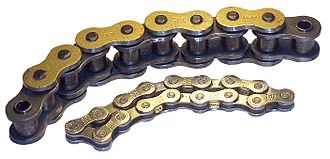There are two types of links alternating in the bush roller chain. The initial type is internal links, having two internal plates held jointly by  two sleeves or bushings upon which rotate two rollers. Internal links alternate with the second type, the outer links, comprising two external plates held together by pins moving through the bushings of the internal links. The “bushingless” roller chain is similar in operation though not in structure; instead of individual bushings or sleeves Drive Chain keeping the inner plates with each other, the plate includes a tube stamped into it protruding from the hole which serves the same purpose. This has the benefit of removing one part of assembly of the chain.
two sleeves or bushings upon which rotate two rollers. Internal links alternate with the second type, the outer links, comprising two external plates held together by pins moving through the bushings of the internal links. The “bushingless” roller chain is similar in operation though not in structure; instead of individual bushings or sleeves Drive Chain keeping the inner plates with each other, the plate includes a tube stamped into it protruding from the hole which serves the same purpose. This has the benefit of removing one part of assembly of the chain.
The roller chain design reduces friction in comparison to simpler designs, leading to higher efficiency and less wear. The initial power transmission chain varieties lacked rollers and bushings, with both inner and external plates kept by pins which directly contacted the sprocket teeth; nevertheless this configuration exhibited incredibly rapid put on of both the sprocket teeth, and the plates where they pivoted on the pins. This problem was partially solved by the advancement of bushed chains, with the pins holding the outer plates passing through bushings or sleeves connecting the inner plates. This distributed the use over a larger area; however the teeth of the sprockets still wore more rapidly than is attractive, from the sliding friction against the bushings. The addition of rollers encircling the bushing sleeves of the chain and offered rolling contact with one’s teeth of the sprockets resulting in excellent resistance to wear of both sprockets and chain as well. There is even very low friction, as long as the chain is usually sufficiently lubricated. Constant, clean, lubrication of roller chains is certainly of primary importance for efficient procedure in addition to correct tensioning